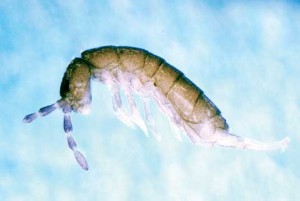Q. Recently, we had sunny, mild days and snow began to melt. Some snow banks were covered by thousands of springtails. How do they survive the winter, and why are they active on snow in such large numbers? George O., WISCONSIN
A. Native insects can survive cold weather. If they couldn’t, they wouldn’t be there. The microhabitat of the springtails apparently was warm enough to get them moving, and the snow supplied the moisture. When the snow disappears, so will the springtails.
Q. A client is finding hairy fungus beetles in a clean room in a surgical instrument packaging building. There’s virtually no water of any kind in the building, but it has a flat roof, which was repaired last year. We inspected thoroughly and set out sticky monitors, but we can’t find a source. We even installed sticky monitors beneath the air-handling ceiling vents, but captured nothing. The problem seems to be reduced during cold weather. What are we overlooking? Bob B., NEW JERSEY
A. You’re correct that there must be a water source. I’d suspect the roof. You said it was repaired last year — probably because it was leaking. The roofing contractor probably didn’t remove all the wet materials on or in the old roof. Once the new roof was installed, anything beneath it can’t breathe, preventing it from drying out. I’ve seen membrane roofs put down over old leaves and other organic debris; you never know what this roofing contractor did. I’d have your client call in the roofing contractor to lift the new membrane and see what lies beneath. Any leaking roof will continue to produce fungus-loving insects if the old, wet material isn’t removed before a new roof covering is installed.
As for ceiling vents, the normal air movement in air-handling systems doesn’t provide a suitable environment in which insects can develop. Sometimes it’s necessary to check vents just to convince clients the problem isn’t coming from the vents, but I’ve never seen an insect infestation inside an air-handling system.
Q. A residential account has a drain fly problem. The homeowners found a leak in a cold-water pipe under their slab. A plumber knocked out a foundation block and repaired the leak. We’ve been asked to solve the fly problem. This slab also has radiant heat, so we’re concerned about drilling at an angle through the foundation to inject an insecticide. How can we do this without risking hitting a radiant heat pipe? What other alternatives do we have? Natasha O., NORTH DAKOTA
A. Drain flies breeding in contaminated soil present the same challenge as phorid flies in these environments: Pesticides seldom solve the problem. Many years ago, I tried to solve a similar problem by injecting a mixture of chlordane and dichlorvos into the soil. It didn’t work.
The ultimate solution is removing the contaminated soil and replacing it with clean fill. Someone should be able to rake out the contaminated soil, because the plumber was able to reach the pipe for repair.
A temporary fix might be placing dichlorvos strips into the space beneath the slab. The vapor should knock down the adults, and break the breeding cycle. I don’t guarantee this procedure
will work, but it might be at least a stopgap measure.
Email your questions about insect identification and pest management technologies and techniques to Dr. Doug Mampe, an industry consultant, at dentomol@aol.com. Your questions most likely will be printed and answered in one of Pest Management Professional’s upcoming Ask the Expert columns.

Leave A Comment